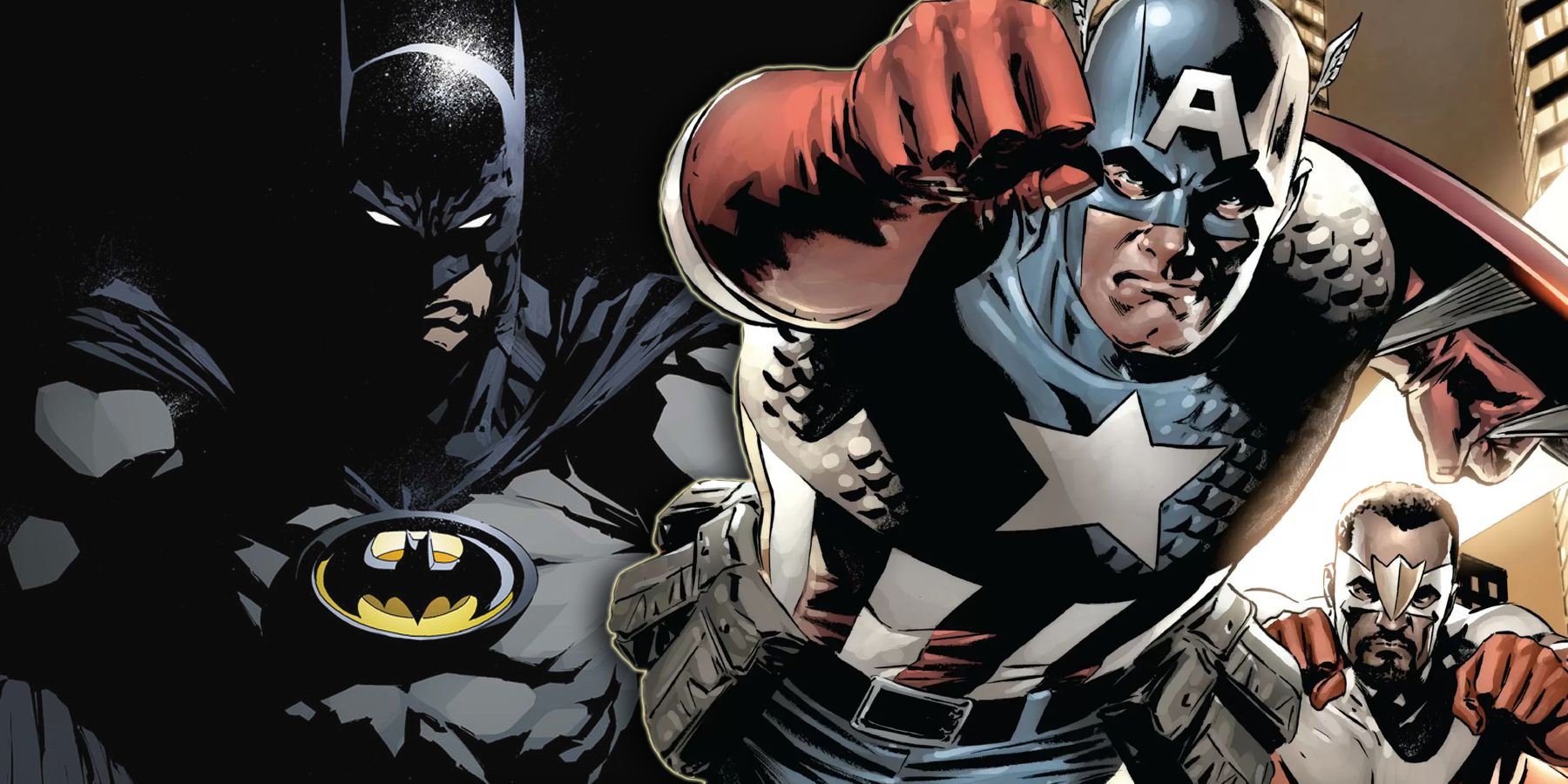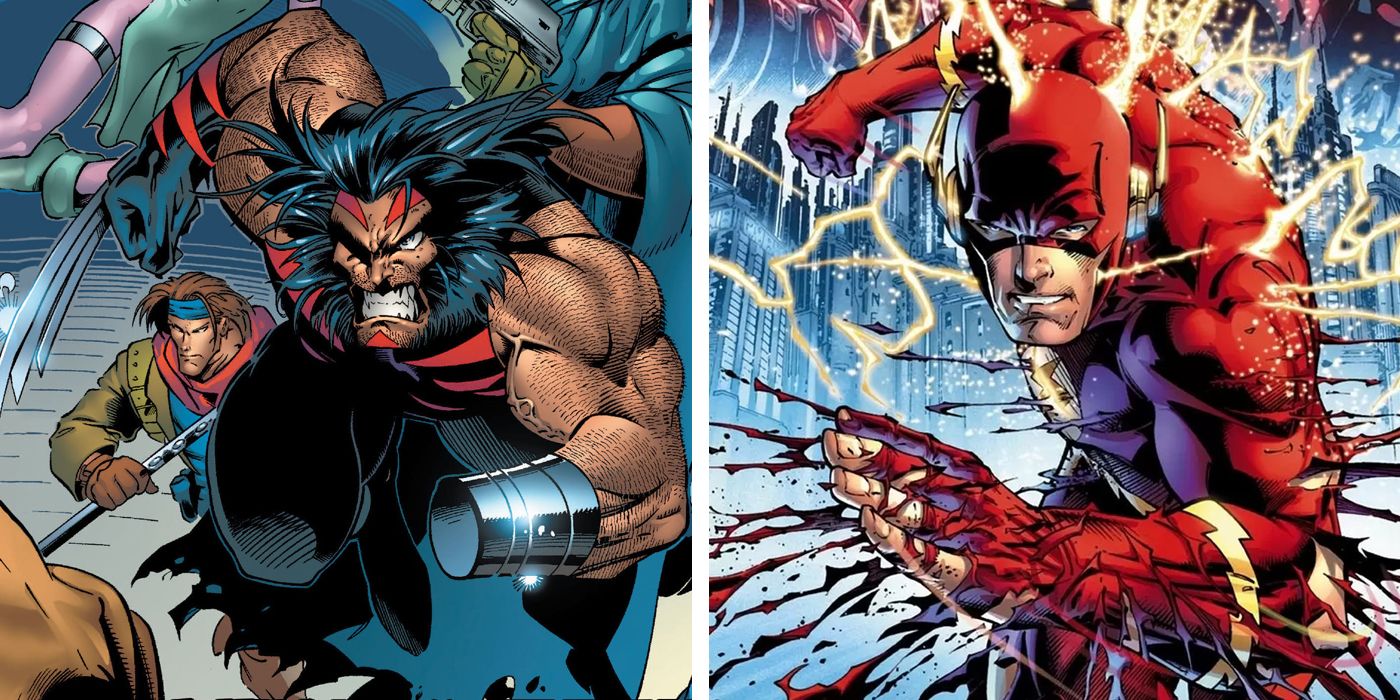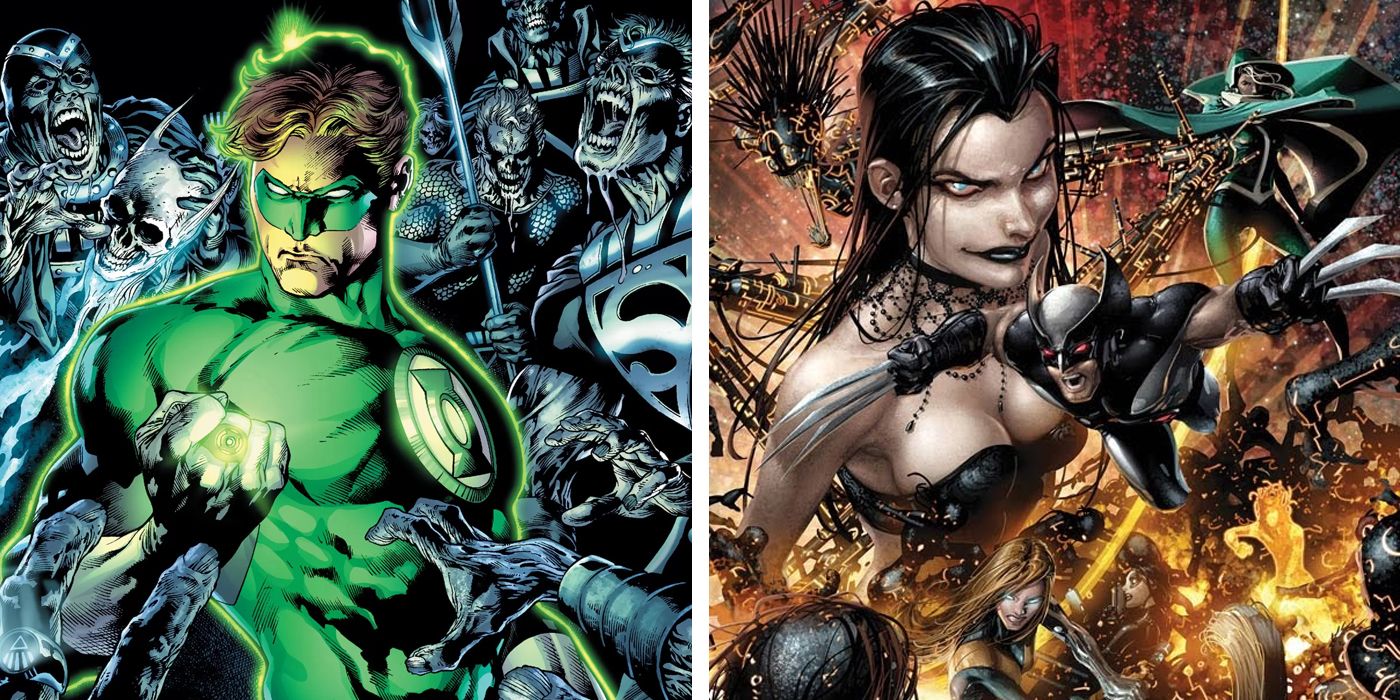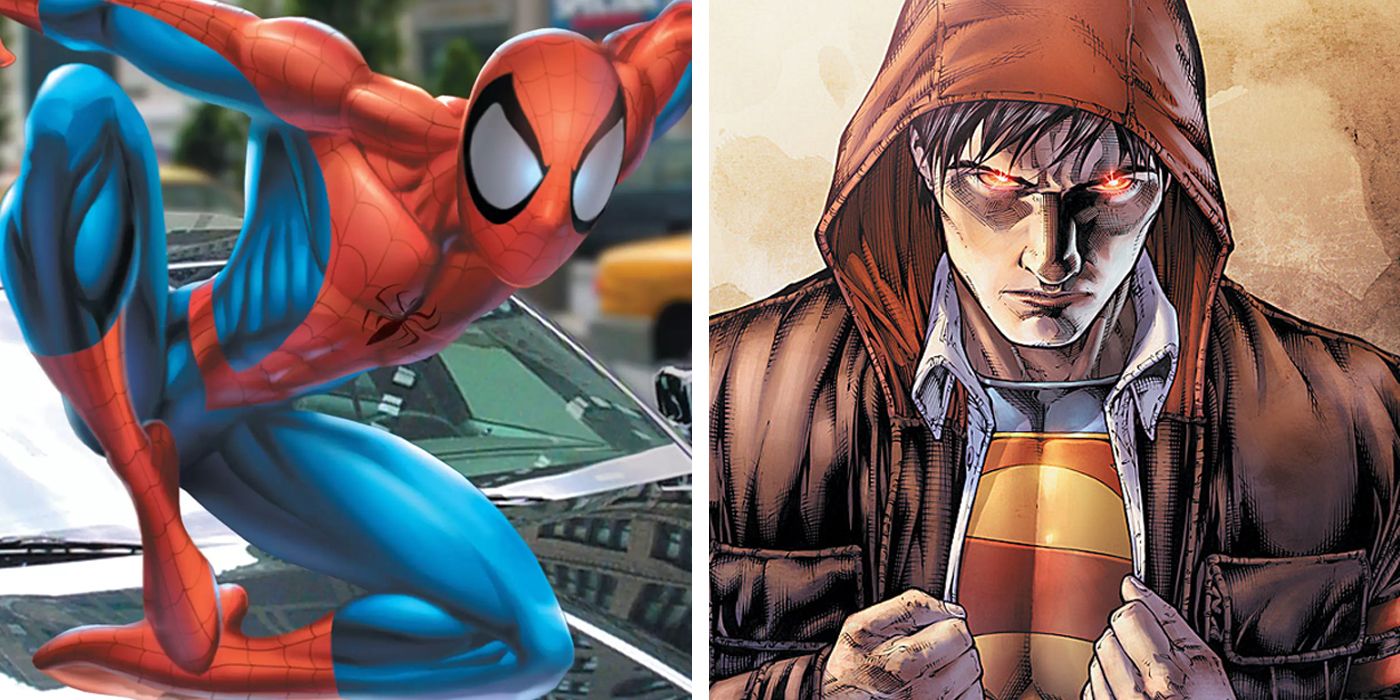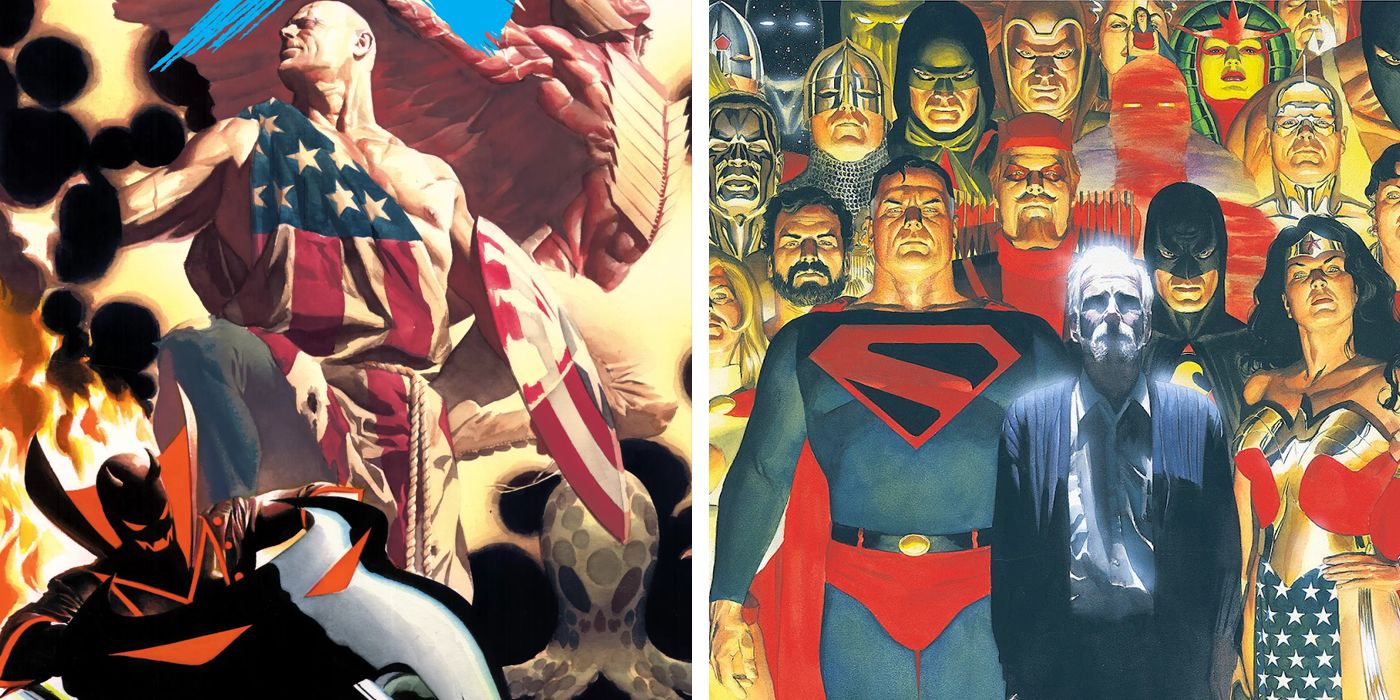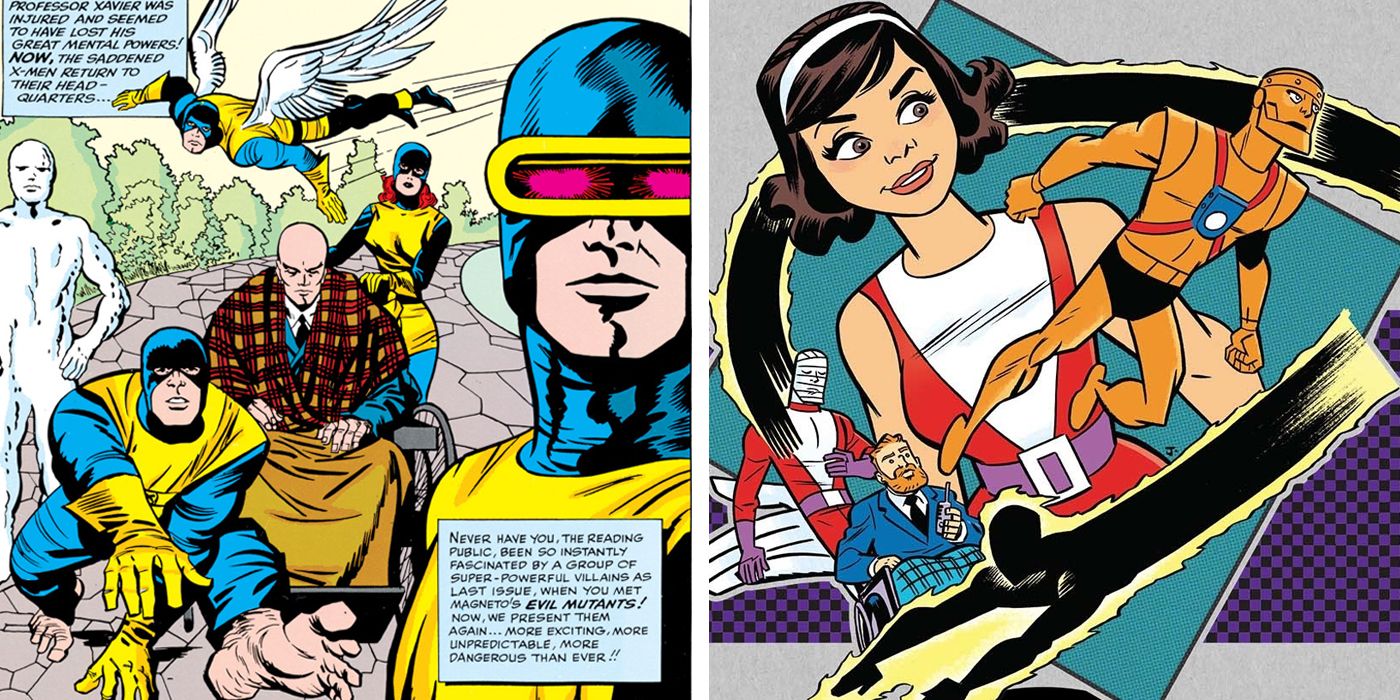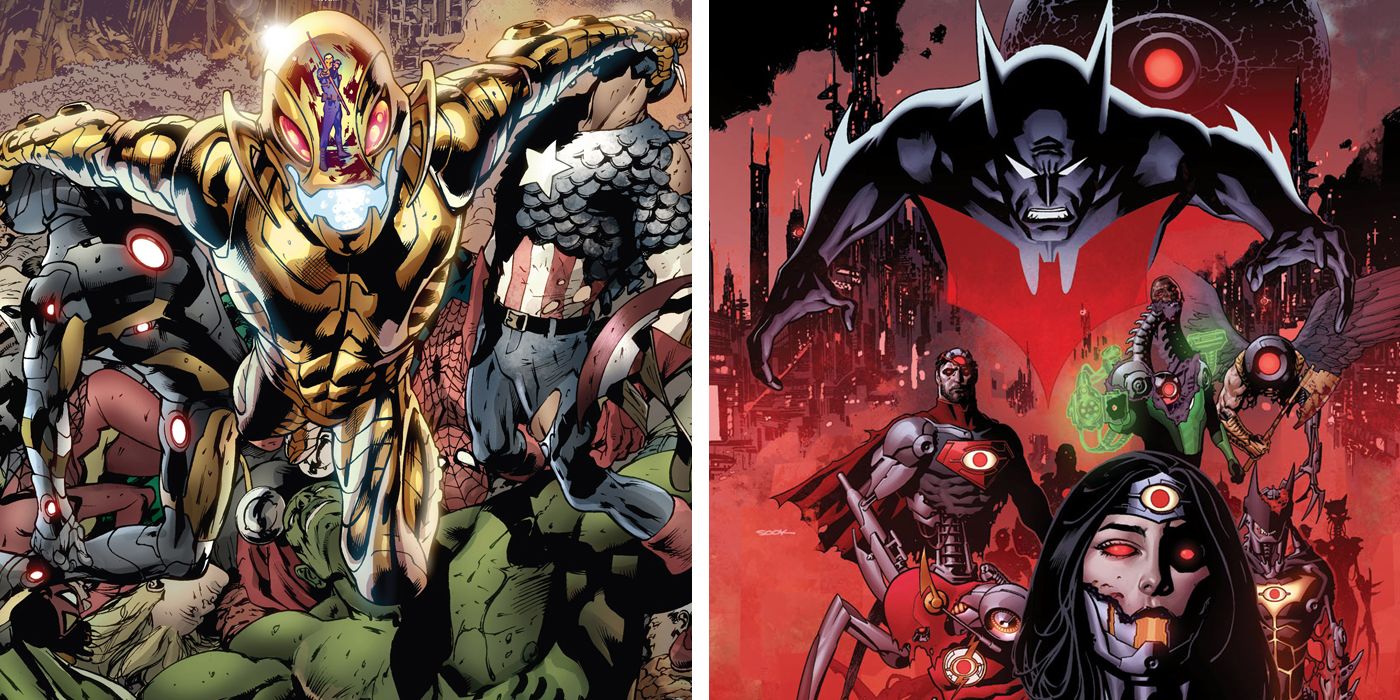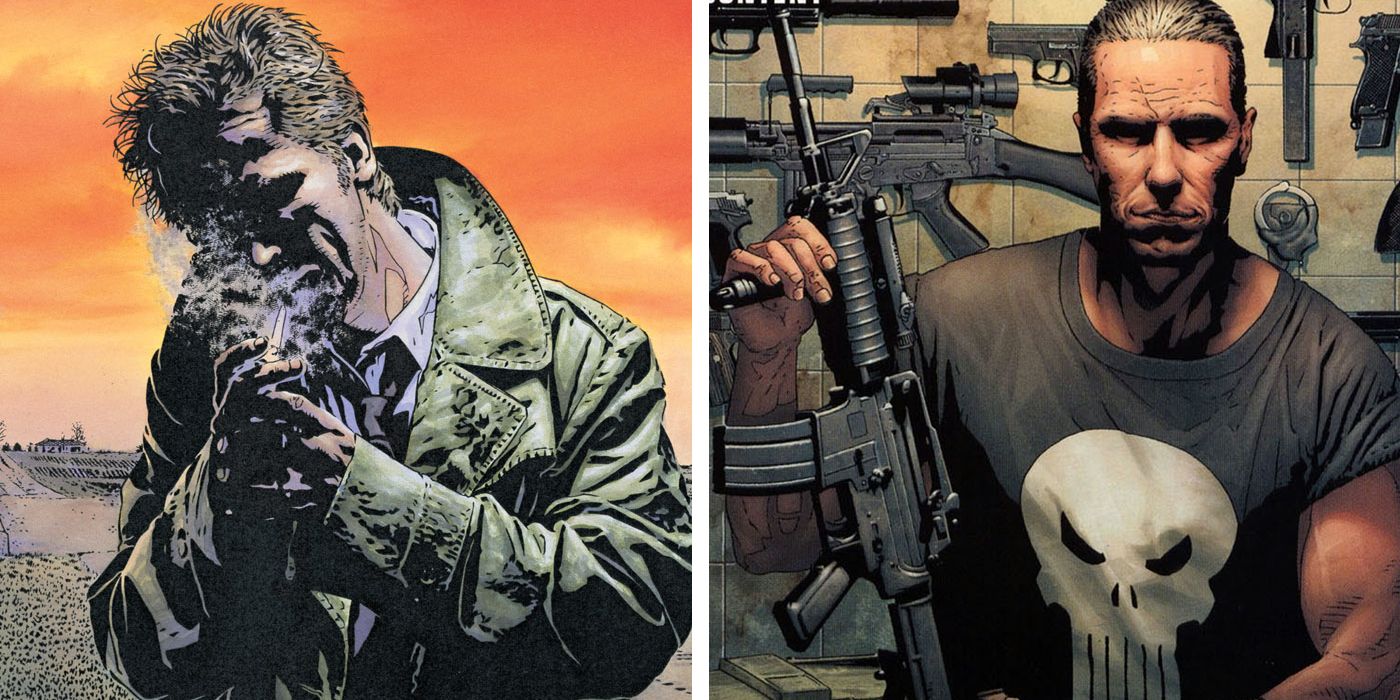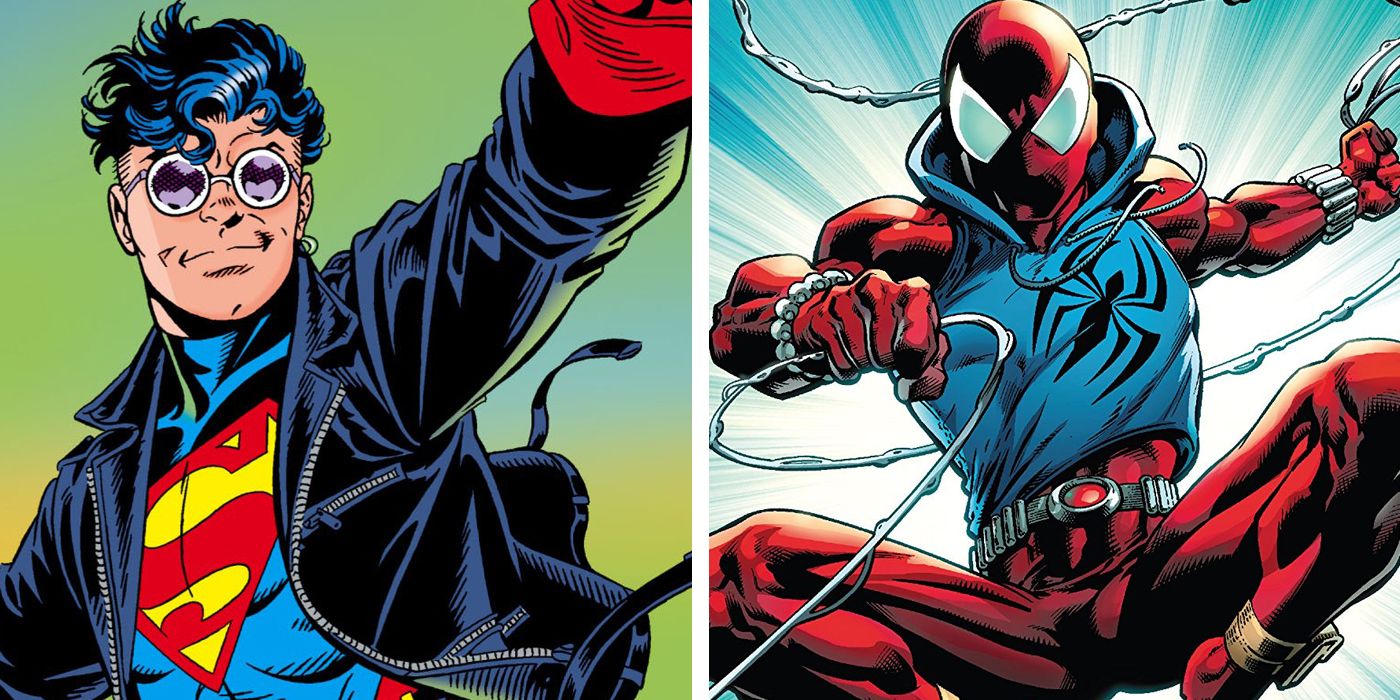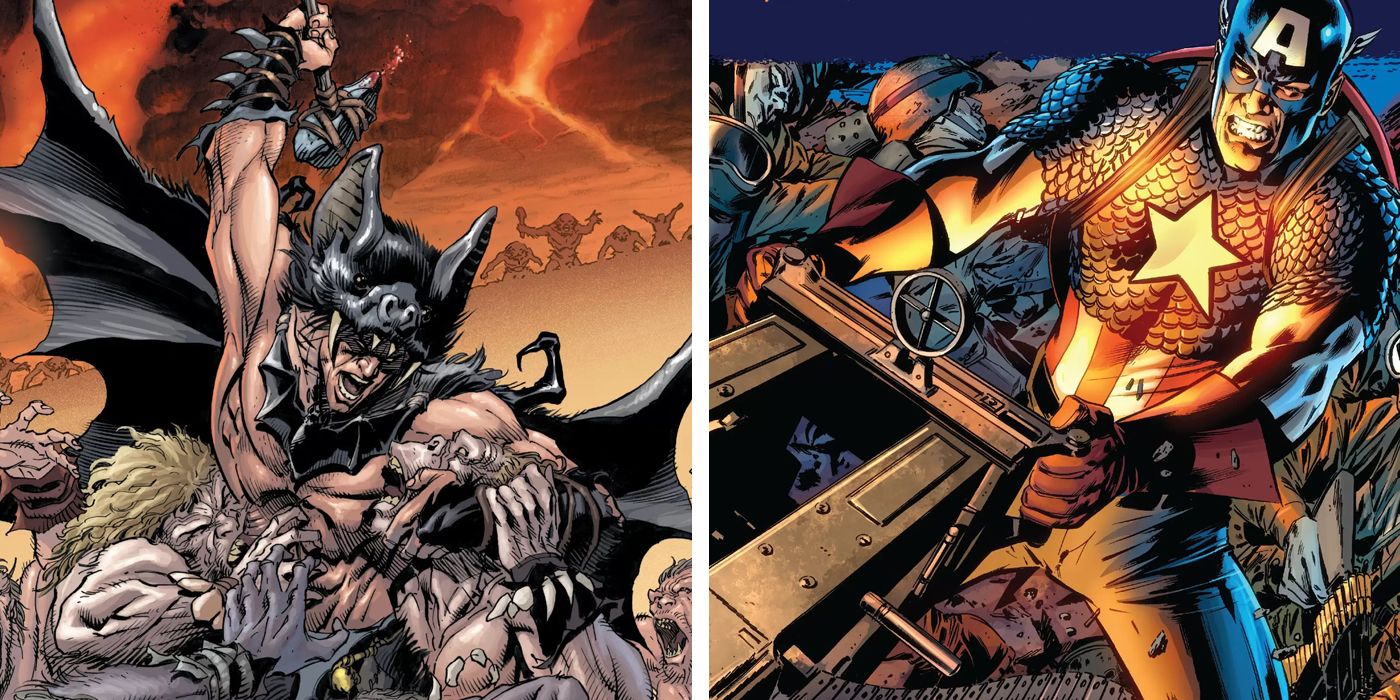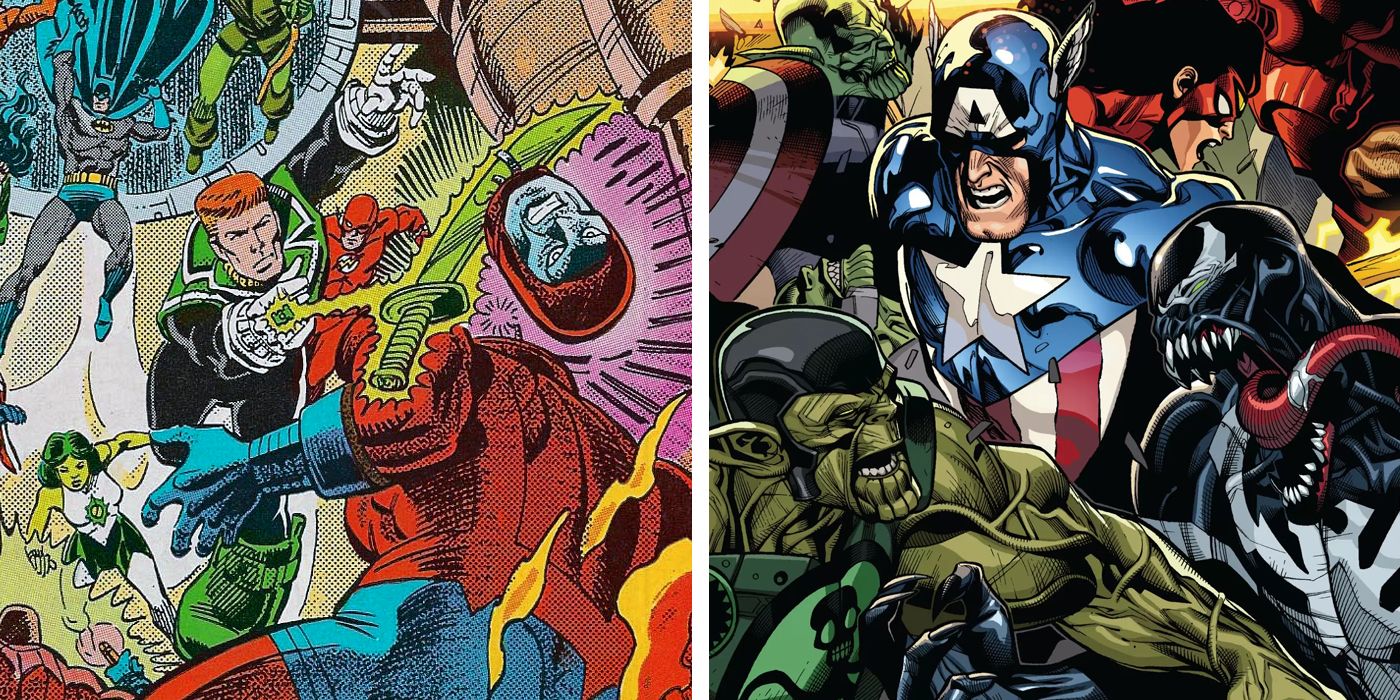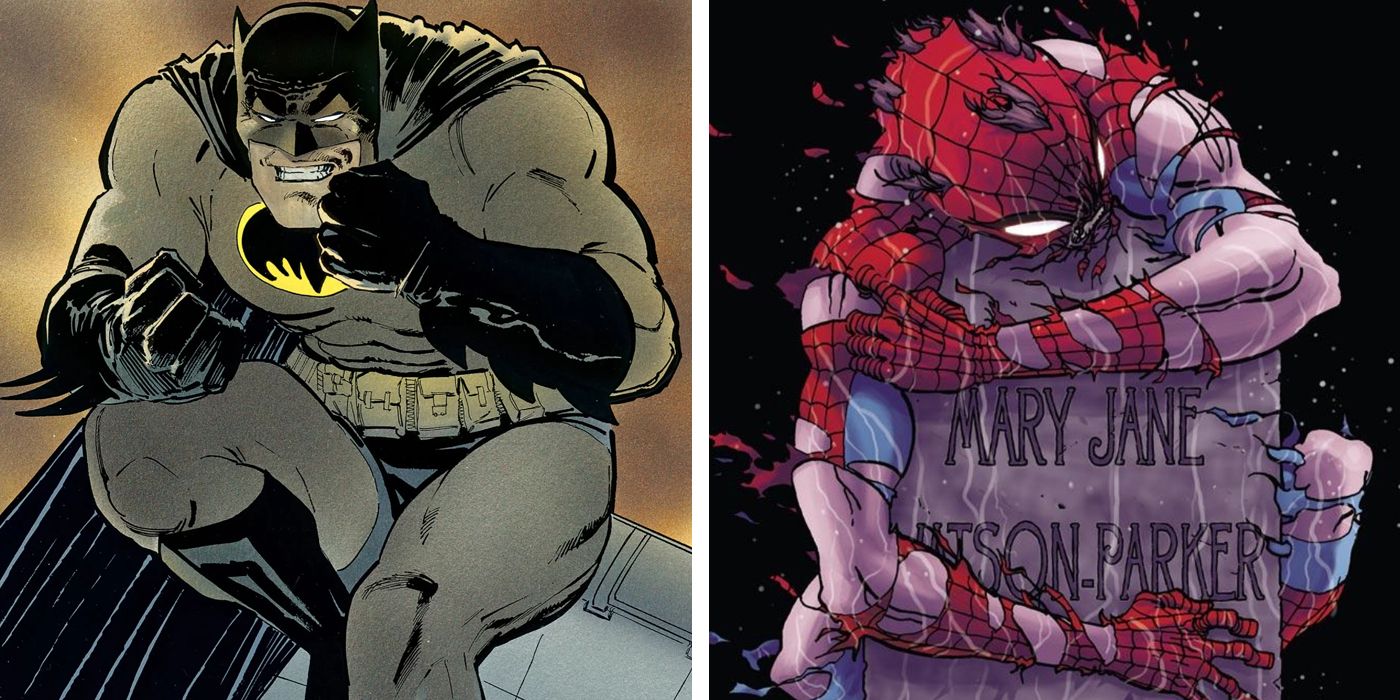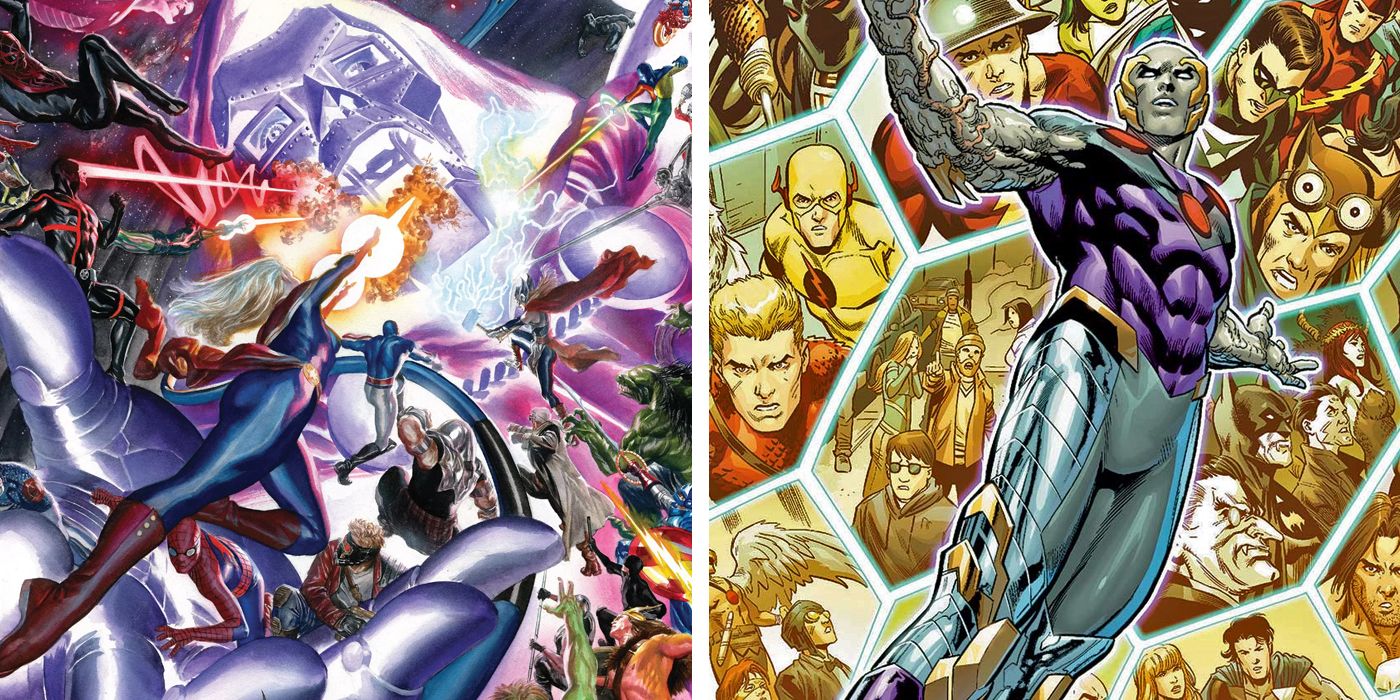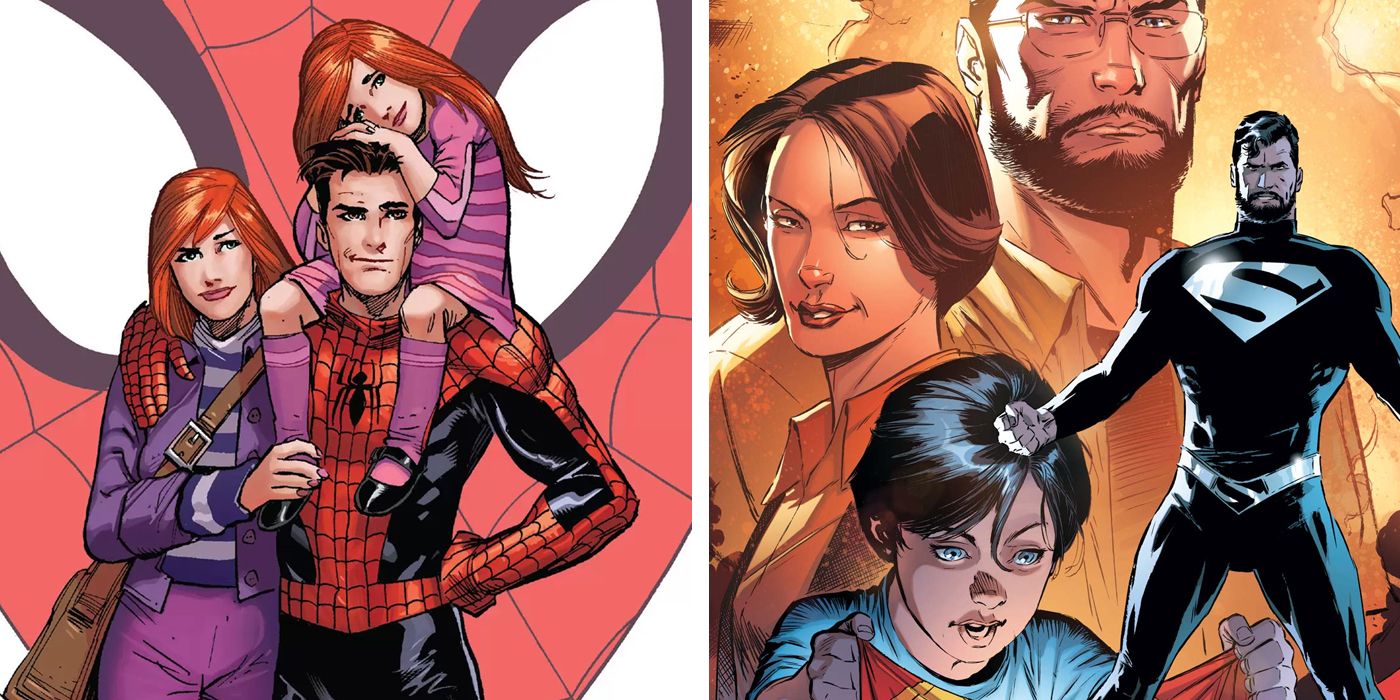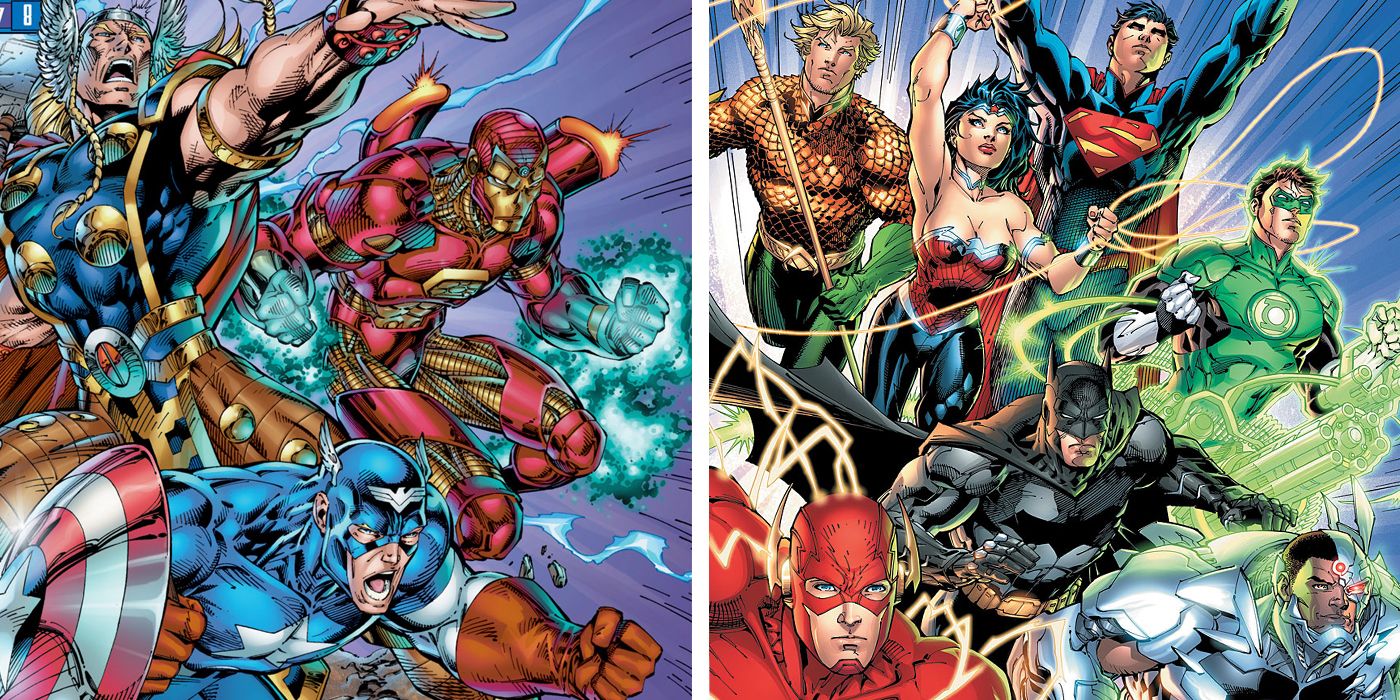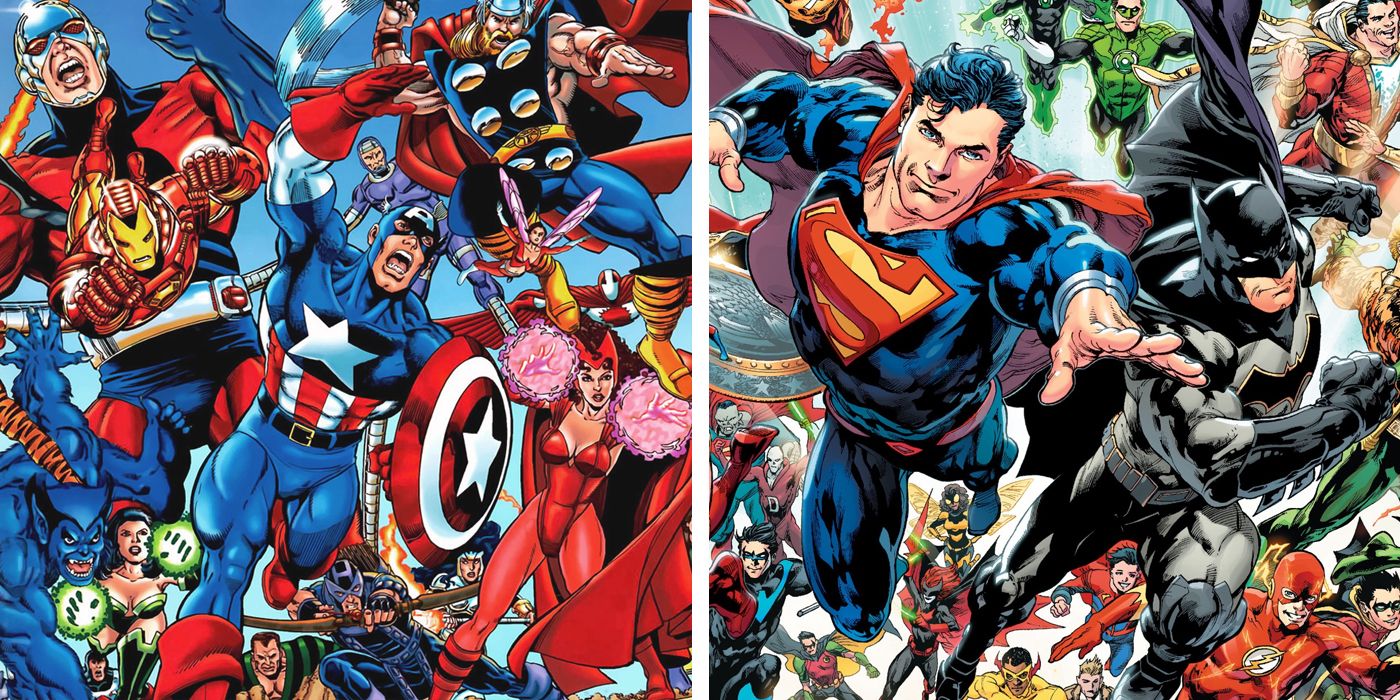Despite all their differences, the worlds of Marvel and DC Comics aren't too dissimilar at the end of the day. In both universes, iconic superheroes have triumphed over evil in an endless array of adventures, told by some of biggest creative minds in comics. However, even the most creative minds can think alike sometimes. As a result, that can leave Marvel and DC's biggest heroes in eerily similar situations. While it's one thing for Marvel and DC to share minor coincidences, like Batman and Spider-Man both battling a villain named the Scarecrow in the same month, it's another thing entirely when major, company-wide stories have identical set-ups or revelations.
RELATED: Blood Drive: The 15 BLOODIEST Heroes and Villains in Comics
Even though this can happen naturally, some of these stories are openly meant to imitate or replicate the other company's successes with their own characters. Now, CBR is counting down 15 times Marvel and DC basically ripped each other off. For this list, we'll be looking at times when stories, set-ups or publishing ventures shared major plot points or ideas. While some of the entries were clearly inspired by each other, others were released too close together to be anything more than deeply odd coincidences inspired by larger ideas in the cultural spectrum.
15 AGE OF APOCALYPSE/FLASHPOINT
In 1995, the X-Men-centric Marvel crossover "Age of Apocalypse" set the template for the massive modern superhero crossover. With work form Scott Lobdell, Joe Madureira, Roger Cruz and Fabian Nicieza, this epic explored the dark alternate world created when Professor X's time-traveling son Legion accidentally killed his father in the past.
In 2011, Geoff Johns and Any Kubert's Flashpoint, DC's Flash created a similarly dark alternate reality by traveling back in time to keep the Reverse Flash from killing his mother. In both crossovers, chart-topping comic series were suspended for several months while new series took place in these drastically different worlds that seemed to be on the edge of total annihilation. While the X-Men's world was eventually restored without too many differences, Flashpoint ended with DC's high-selling New 52 reboot in 2011. Both crossovers have been loosely adapted in other media, and generally well-remembered.
14 BLACKEST NIGHT/NECROSHA
Thanks in no small part to The Walking Dead, zombies were all the rage just a few years ago. Naturally, both Marvel and DC pit some of their heroes against super-powered zombies in a pair of 2009 crossovers. The first of these crossovers, Geoff Johns and Ivan Reis' Blackest Night, brought the DC Universe together to fight the death lord Nekron and the Black Lanterns: monstrous, undead versions of DC's fallen heroes and villains.
Just a few months later, the X-Men and their affiliate teams starred in the remarkably similar "Necrosha." In that crossover, by Craig Kyle, Christopher Yost, Mike Carey, Zeb Wells and Clayton Crain, the immortal X-villain Selene used an alien virus to bring back dozens of deceased X-Men allies and enemies. While the X-Men crossover faded from memory fairly quickly, Blackest Night has a reputation as one of the biggest DC stories of the past decade.
13 ULTIMATE MARVEL/EARTH ONE
In 2000, Marvel updated its characters for the 21st century with the Ultimate Marvel imprint. In titles like Brian Michael Bendis and Mark Bagley's Ultimate Spider-Man, creators imagined a world where Marvel's heroes emerged today to blockbuster success. While the Ultimate Universe initially followed the regular Marvel Universe's blueprint, it eventually evolved into a drastically different world, with new heroes like Miles Morales' Spider-Man.
A decade after the instant success of the Ultimate comics, DC updated its heroes with 21st century origins in Earth One. Instead of ongoing series, Earth One focused on original graphic novels by top-tier creators. Starting with J. Michael Straczynski and Shane Davis' Superman: Earth One in 2010, the Earth One titles have received moderately positive reviews for their modern retellings of classic origin stories. Both updated universes were major inspirations for Marvel and DC's various cinematic offerings.
12 KINGDOM COME/EARTH X
Alex Ross and Mark Waid examined the dark possible future of the DC Universe in 1996's Kingdom Come. With Ross' jaw-dropping fully-painted artwork, the series followed pastor Norman McCay as he witnessed a future where DC's aging classic heroes were replaced by a violent new generation of anti-heroes.
In 1997, Ross created an outline for a similar project using Marvel's heroes. Jim Krueger and John Paul Leon used those notes to create Earth X. In that series, X-51, the Machine Man, was chosen by the Watcher to watch over a world where everyone on Earth had super-powers. This series also featured aging classic heroes who struggled to fight against dark young villains and cosmic threats. While Kingdom Come still holds a place as one of the best comics of the 1990s, Earth X's two cosmic-focused sequels faced diminishing returns, and the story has become one of Marvel's many dark futures.
11 X-MEN/DOOM PATROL
In 1963, two brand new teams brought super-powered outsiders together to form the "strangest" superhero teams ever assembled. In June 1963, Arnold Drake, Bruno Premiani, Murray Boltinoff and Bob Haney created the Doom Patrol, "the world's strangest superheroes," in DC's My Greatest Adventure #80. Just a few months later, Stan Lee and Jack Kirby introduced the X-Men, "the strangest super-heroes of all," in September 1963's X-Men #1.
Beyond their taglines, both teams were brought together by genius wheelchair-bound mentors, the X-Men's Professor X and Doom Patrol's Chief. While the X-Men fought Magneto's Brotherhood of Evil Mutants, the Doom Patrol battled the Brotherhood of Evil. Although Drake suggested that Lee could have based the X-Men on Doom Patrol, the issue was never definitively settled. Given the closeness of initial release and that era's production schedule, it's generally assumed that these similarities are ironic coincidences, brought on by parallel lines of thought.
10 AGE OF ULTRON/FUTURES END
A few years after their worlds were devastated by zombie infestations, both Marvel and DC created futures that were taken over by killer robots. After a lengthy tease, Brian Michael Bendis, Bryan Hitch and Brandon Peterson took Marvel's heroes to the Age of Ultron, where the titular cybernetic Avengers foe violently took over Earth in a company-wide crossover.
In 2014, creators like Dan Jurgens, Keith Giffen, Brian Azzarello and Jeff Lemire created a war-torn future where DC's sentient artificial intelligence Brother Eye ruled a grotesque techno-organic empire in The New 52: Futures End. Although Ultron spent more time in the brutal future, both crossovers focused on heroes who traveled back in time to keep their futures from ever happening in Terminator-esque plots. Since each crossover highlighted different aspects of similar set-ups, they both ultimately felt different enough to co-exist without stepping on each other's toes, despite strikingly similar set-ups.
9 VERTIGO COMICS/MAX COMICS
In the late 1980s, DC's line of critically-acclaimed mature readers comics pushed the boundaries of what mainstream American comics could be. In 1993, DC gave these titles an official home with Vertigo Comics. Over the next few decades, Vertigo published a mix of adult takes on relatively minor DC characters like Doom Patrol and Constantine, along with creator-focused titles like Preacher.
Although Marvel's Epic Comics imprint featured some creator-owned mature readers titles in the 1980s and early 1990s, Marvel's answer to Vertigo came with Max Comics in 2001. Like Vertigo, this imprint focused on the mature readers content that wasn't allowed in the Marvel Universe. While the Punisher became the imprint's hyper-violent star, Jessica Jones made her debut in Brian Michael Bendis and Michael Gaydos' Alias before joining the regular Marvel Universe. In 2011, Vertigo's DC characters were reintegrated into the DC Universe, and Max quietly folded in 2014.
8 SUPERBOY/SCARLET SPIDER
In the 1990s, comics went a little clone-crazy. In a pair of lengthy storylines based on elements of 1970s comics, both Superman and Spider-Man were briefly replaced by their hipper clones. Created by Karl Kesel and Tom Grummett in 1993's Adventures of Superman #500, Superboy was built by Project Cadmus to replace the recently-deceased Superman. After Superman was revived, Superboy came into his own as a teenage hero.
In 1994, Marvel reintroduced a clone of Spider-Man who had been created by the Jackal in a 1970s storyline by Gerry Conway and Ross Andru. As Ben Reilly, this clone became the Scarlet Spider before taking Peter Parker's place as Spider-Man. After a year as Spider-Man, Reilly was killed and Parker returned as Spider-Man due to fan outcry. The similarities between Superboy and Reilly were highlighted when both were merged to form Spider-Boy during the Marvel Vs. DC crossover.
7 CAPTAIN AMERICA: REBORN/BATMAN: RETURN OF BRUCE WAYNE
By 2010, both Batman and Captain America were dead, or so it seemed. After Captain America's apparent death in the 2007 finale of Civil War and Batman's apparent end in 2009's Final Crisis, both heroes were revealed to have merely been "unstuck in time." In Captain America: Reborn, by Ed Brubaker and Bryan Hitch, Captain America was forced to live moments from his life over again as part of the Red Skull's plan to take over his body.
A few months later, Bruce Wayne was sent to the beginning of history after being hit by Darkseid's Omega Beams. Over the course of Batman: The Return of Bruce Wayne, Grant Morrison and an all-star team of artists followed Batman as he fought his way through various historical eras. While both heroes eventually returned to the present, their sidekicks, Bucky and Dick Grayson, took up their mentor's mantles while they were away.
6 MILLENNIUM/SECRET INVASION
From a distance, the mostly forgotten 1988 DC crossover Millennium and Marvel's 2008 crossover Secret Invasion don't seem too similar. While Brian Michael Bendis and Leinil Yu's story focused on an alien invasion by the shape-shifting Skrulls, Steve Englehart and Joe Staton's 1980s tale focused on a search for the new Guardians of the Universe and an infiltration by the Manhunters, an ancient group of alien robots.
Both crossovers were sold on the idea that some characters would be revealed to be alien sleeper agents. Although supporting characters like Commissioner Gordon and Lana Lang were revealed to be Manhunter spies, their involvement was explained away with mind-control or robot duplicates. Similarly, Skrulls mainly took the places of recognizable B-list heroes like Spider-Woman, Hank Pym, Elektra and Black Bolt. Despite the insidious nature of both alien infiltrations, both crossovers found loopholes that left most of their major characters' supporting casts untouched.
5 DARK KNIGHT RETURNS/SPIDER-MAN: REIGN
In 1986, Frank Miller's The Dark Knight Returns offered a character-defining reinterpretation of Batman. Over the course of four issues, an older Batman came out of retirement to save a dark, future version of Gotham City. With the help of a Carrie Kelly, a new female Robin, Batman took on old and new foes before returning to his war on crime.
Twenty years later, Marvel gave Spider-Man a very similar treatment with 2006's Spider-Man: Reign. In Kaare Andrews' tale, an older Spider-Man came out of retirement to battle several of his old enemies in a nightmarish future New York. With help from J. Jonah Jameson, Hypno-Hustler Sandman and his daughter, Spider-Man saved the city from a symbiote infestation and a corrupt city government. Although it didn't achieve the same mainstream success as Miller's iconic Batman tale, Andrews' Spider-Man story included a number of stylistic nods to its inspiration.
4 SECRET WARS/CONVERGENCE
In 2015, both of Marvel and DC's major summer crossovers gave readers a chance to revisit some of the most famous alternate realities and parallel dimensions in comics. Starting in April 2015, Jeff King, Ethan Van Sciver, Dan Jurgens and other creators revisited some of DC's most famous eras in Convergence. In the series, a group of alternate reality heroes worked together to defeat Brainiac, who forced cities from parallel timelines and alternate worlds to fight each other.
Just a month later, Jonathan Hickman and Esad Ribic's Secret Wars saw Dr. Doom create Battleworld out of Marvel's alternate realities. While he tried to keep those parallel kingdoms apart, they eventually worked together to overthrow Doom and reset the Marvel Multiverse. While Secret Wars marked the last appearances of characters like Mr. Fantastic and Invisible Woman, Convergence set the stage for the return of a more classic Superman and Lois Lane.
3 SPIDER-MAN: RENEW YOUR VOWS/SUPERMAN: LOIS AND CLARK
In the never-ending effort to make Superman and Spider-Man seem younger, both heroes were eventually separated from their respective wives, Lois Lane and Mary Jane. While Spider-Man lost his marriage in a literal deal with the devil, he got it back during Secret Wars. In the alternate reality of Dan Slott and Adam Kubert's Amazing Spider-Man: Renew Your Vows, Spider-Man and Mary Jane stayed married and had a daughter named Annie.
Similarly, slightly older versions of Superman and Lois Lane emerged from Convergence married with a child named Jon in Dan Jurgens and Lee Weeks' Superman: Lois and Clark. Both titles continued on well after the crossovers that birthed them. Although Spider-Man and his family have stayed in their reality, Superman and his family made their way into the main DC Universe. During the ongoing DC Rebirth initiative, Superman and his family became DC's main versions of those characters.
2 HEROES REBORN/NEW 52
While Marvel's Avengers might dominate the pop cultural landscape now, they weren't doing so well by the mid-1990s. To combat sluggish sales, Marvel did the unthinkable, and decided to reboot the characters with Jim Lee and Rob Liefeld, mega-star artists who left the company a few years earlier to form Image Comics. In the Heroes Reborn reboot, the Avengers and Fantastic Four were given a new universe, new first issues and updated origins for the 1990s. They even crossed over with some of Lee's WildStorm characters.
Not long after Lee became DC's Co-Publisher, DC underwent a company-wide reboot with 2011's New 52. This reboot gave all of DC's characters new, updated origins and featured work from Lee, Liefeld and other Heroes Reborn veterans. Lee's WildStorm characters were merged into DC's main universe, and DC's titles all relaunched with new first issues. Both high-selling, controversial reboots sharply divided fans and critics.
1 HEROES RETURN/DC REBIRTH
Given the somewhat lukewarm reception from longtime readers, both Marvel and DC undid big parts of their modern reboots after a short time. Marvel's Heroes Reborn titles ended after 13 issues, and the Avengers and company returned to the main Marvel Universe with Heroes Return. After the multiversal shenanigans were done, these heroes returned to their classic forms in bright, critically-acclaimed back-to-basics stories by creators like Mark Waid and Kurt Busiek.
In 2016, DC Chief Creative Officer and fan-favorite writer Geoff Johns made headlines with DC Rebirth. While Rebirth's over-arching storyline is still unfolding, this relaunch has achieved commercial and critical success by returning DC's heroes to bright, back-to-basics stories. While both revivals focused on bringing back classic elements, they also embraced innovations that made their characters more relevant in an ever-changing modern world. By embracing this modern classicism, Marvel and DC created bright futures for their most iconic superheroes.
Stay tuned to CBR for all the latest in comics and pop culture. Let us know what your favorite time Marvel copied DC or vice versa was in the comments below!

